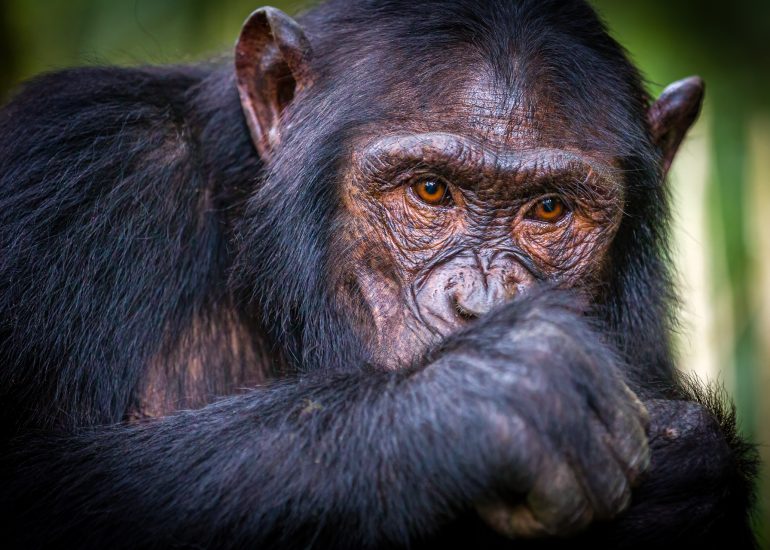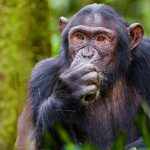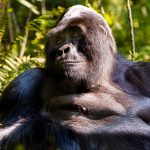Uganda
Journal
The Pearl Of Africa
Part 5
Day 11
Fort – Portal to Queen Elizabeth National Park
The distance between Fort Portal and Kasenyi Safari Camp inside the Queen Elizabeth Nationalpark is approximately 90 kilometers, and the estimated travel time is around 2-3 hours depending on traffic and road conditions.
The drive takes again through rural areas, small towns, and picturesque landscapes. We see traditional Ugandan villages, farms, and cattle grazing in the fields. The road is mainly paved, but there are some sections of the route that are bumpy or unpaved, especially aw we get closer to the national park.
There is a spot on the route where shortly stop and and Innocents explains us that we just right know have crossed the Equator line.
At this point, however, the crossing is quite unspectacular. A sign indicates that you have now crossed the equator and nothing can be seen further here. Elsewhere later on our journey we pass the so-called Equator Monument. But as I said, more on that later.
Once we arrived at Queen Elizabeth National Park, we need to pay the park entrance fees and obtain the necessary permits to access the park. This is handled by Innocent our guide who really seems to know each and everybody we meet on the tour. After this administrative part we continue our journey through the park to reach Kasenyi Safari Camp.
Along the way, we see a variety of wildlife, some patas monkeys, buffalos, antelopes, and some ground hornbills. The scenery is breathtaking, with rolling hills, lush forests, and stunning views of the park’s savannah plains.
The Queen Elizabeth Nationalpark
The road conditions in Queen Elizabeth National Park can vary depending on the season and the location within the park. Some roads are well-maintained and paved, while others are more rugged and require a 4×4 vehicle to navigate. It’s always a good idea to check with about the road conditions.
Queen Elizabeth National Park is home to a wide variety of wildlife, including elephants, lions, leopards, buffalos, hippos, crocodiles, antelopes, and many more. The park is also known for its birdlife, with over 600 species recorded, making it a paradise for birdwatchers. Some of the most iconic bird species found in the park include the African Fish Eagle, Grey Crowned Crane, and the Shoebill Stork.
In addition to wildlife and birdlife, Queen Elizabeth National Park is also known for its stunning landscapes, including the Kazinga Channel, which connects Lake Edward and Lake George and is a popular spot for boat safaris. Other highlights of the park include the Kyambura Gorge, which is home to a population of chimpanzees, and the Ishasha sector, where visitors can see tree-climbing lions. Our plan is to go on a boat safari on the Kazinga Channel and later we travel further to the Ishasha sector of the park.
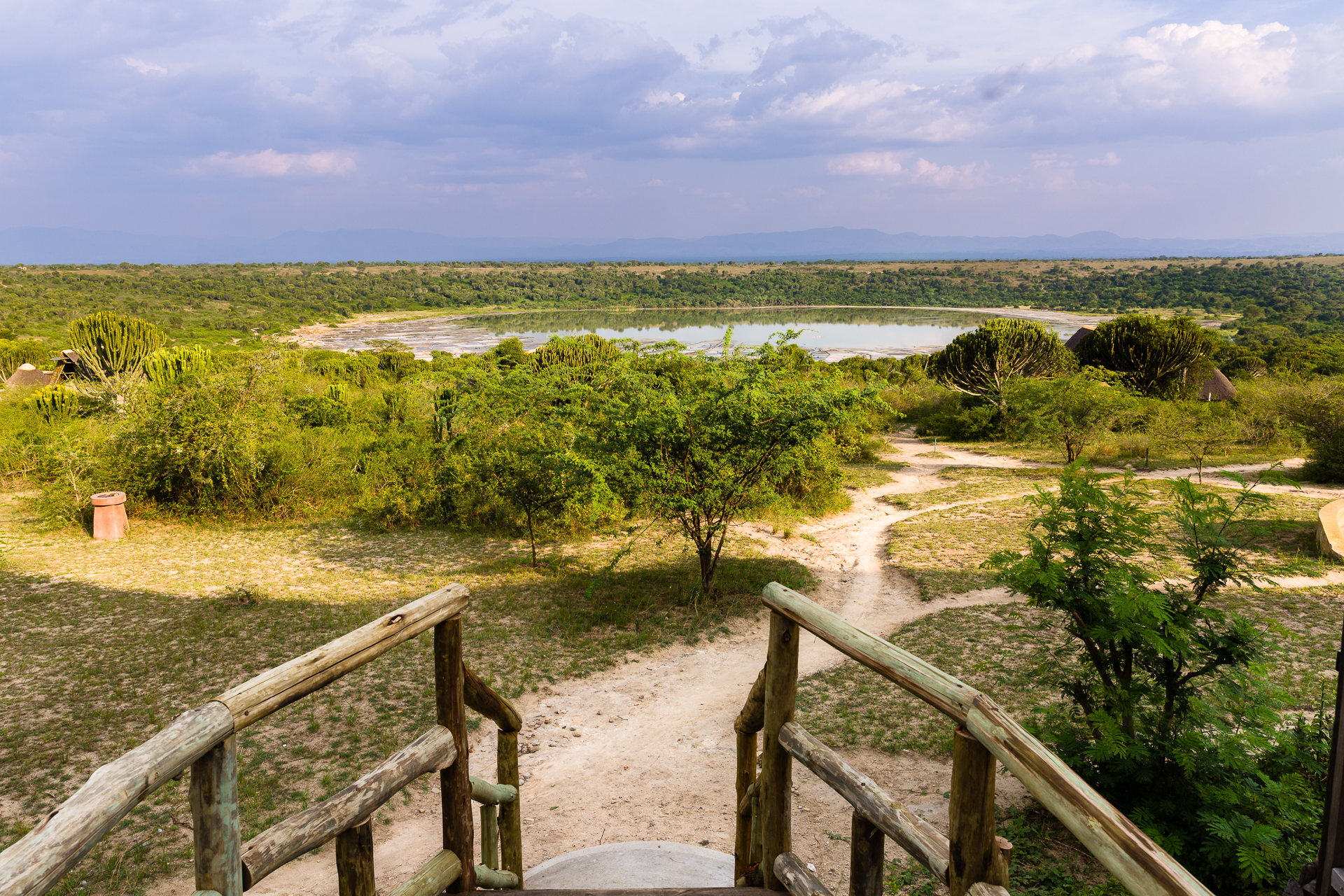
Kasenyi Safari Camp
Kasenyi Safari Camp
We arrive at the Kasenyi Safari Camp and Phillip K. Kiboneka the manager of the camp welcomes us warmly. Kasenyi Safari Camp is located in the northern part of Queen Elizabeth National Park, Uganda. The camp is situated on a hill overlooking the vast savannah plains of Kasenyi, which is known for its large population of lions and other wildlife.
The camp is nestled among acacia trees, and the surrounding area is characterized by rolling hills, open grasslands, and scattered trees. The landscape is dotted with rocky outcrops, which offer spectacular views of the surrounding plains and the distant Rwenzori Mountains.
Kasenyi Safari Camp is surrounded by a natural ecosystem that supports a diverse range of wildlife. Elephants, buffalos, antelopes, hyenas, and warthogs are commonly seen in the area and in the camp.
There is also a crater lake located close to the Camp and from the Restaurant terrace and from the tented rooms you have an excellent view on it. It is a shallow and highly saline lake that is surrounded by salt pans where locals extract salt for consumption and trade. Visitors can take a guided tour of the salt pans to learn about the salt extraction process and the cultural significance of salt in the region.
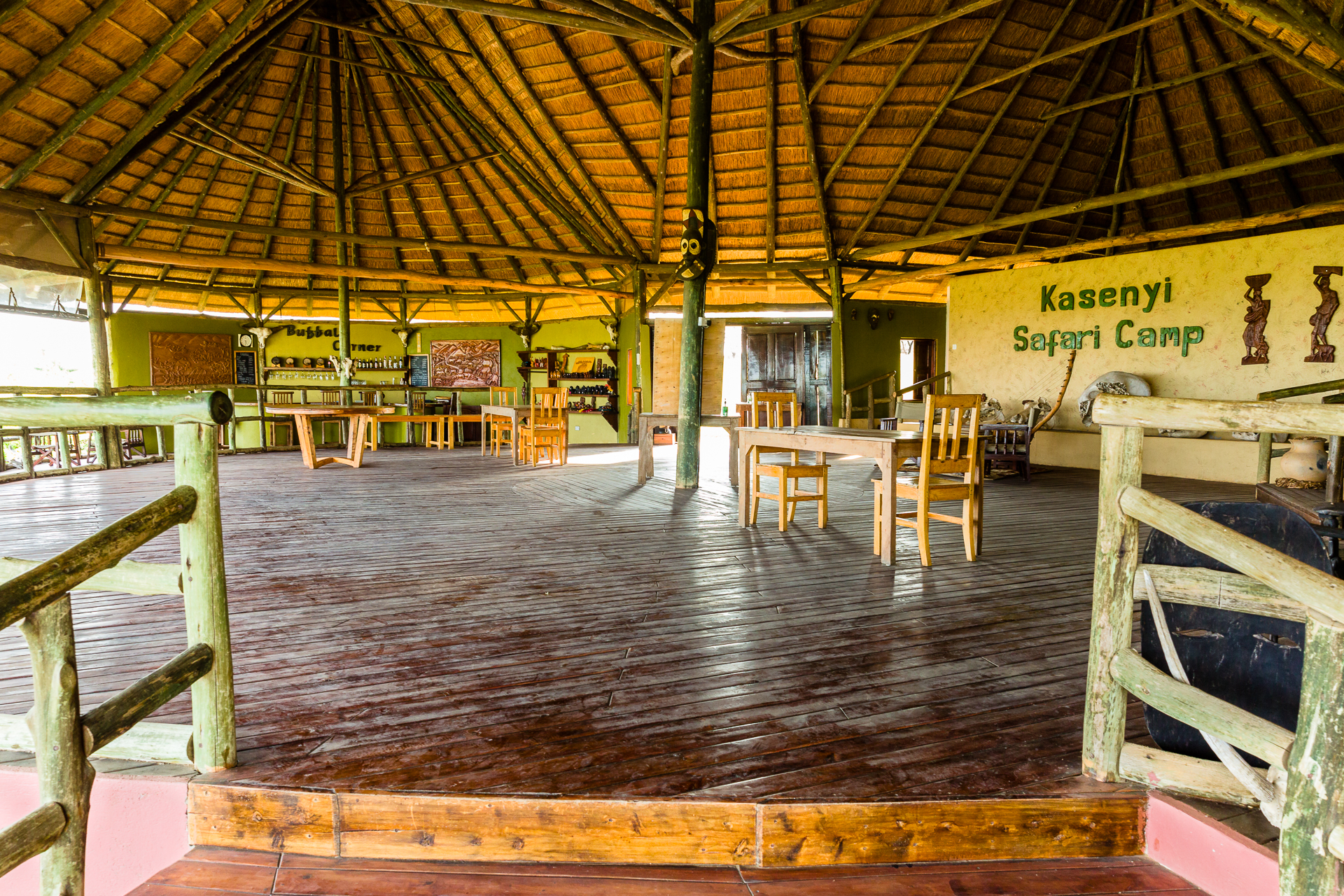
Kasenyi Safari Camp
In the evening we have dinner on the terrace of the Kasenyi Camp. We see a beautiful sunset and we eat our dinner accompanied by the moon and the stars.
Philip explains us that once we want to go back to our tent we need to be guarded by the two guys in the military clothes and with the riffles. The reason is simple. It is pitch dark and the raptors are on the move. Later in the night we hear a hyaena underneath our tent (The tent is on a wooden frame). And there are also a lot of other noises. The sound of the savanna guides us into our dreams. Tomorrow we will see the Kazinga Channe
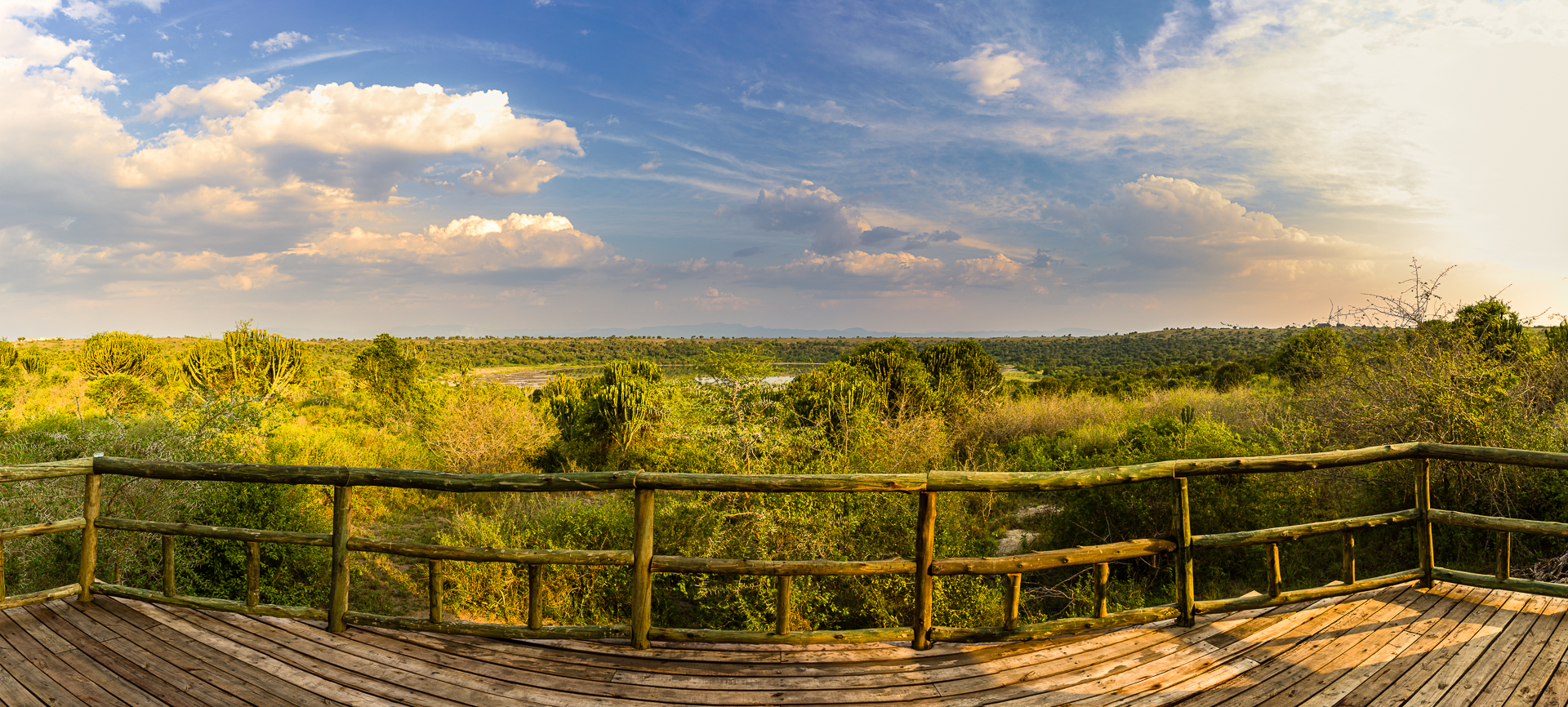
Kasenyi Tent with balcony and a view
Day 12
Kazinga Channel
In the morning we make another game drive and we see a lot of birds and antelopes. Nature does not want to give us other animals today and the birds are beautiful anyway.
After lunch we drive to the channel. Before we embark our boat Innocent has to organize and clarify some things. The reason is simple and complicated at the same time. The only bridge in the region is under construction and the ferry across the Kazinga Channel which is capable to transport also cars is out of service. The question is now: how do we get our minibus across the river?
„Don’t worry – everything is possible in Uganda“. This is the answer from Innocent. And it is an answer you can rely on. Our guide has an idea. But before we solve the problem, embark a boat and then we start to explore the Kazinga Channel.
The Kazinga Channel is a natural waterway that connects Lake George and Lake Edward in Queen Elizabeth National Park, Uganda. It is approximately 40 kilometers long and up to 2 kilometers wide, making it a significant water source and a major attraction for wildlife and visitors to the park. A boat safari on the Kazinga Channel is a popular activity that offers a unique opportunity to see a variety of wildlife, including hippos, crocodiles, elephants, buffalos, and a wide range of bird species.
Hippos: The Kazinga Channel is home to one of the largest concentrations of hippos in Africa, and a boat safari offers a chance to see these massive creatures up close. Hippos can be seen swimming, grazing, and lounging in the water, and their distinctive grunts and snorts can be heard from the boat. Here is really an opportunity to come close – very close to the hippos.
The channel is also home to Nile crocodiles, which can grow up to 6 meters in length. These apex predators can be seen basking in the sun along the banks of the channel or swimming in the water, and they are known for their stealth and power.
Elephants and buffalos are often seen along the banks of the Kazinga Channel, drinking, bathing, and grazing on the lush vegetation. These majestic animals are a highlight of any boat safari, and visitors can observe them from a safe distance on the water.
And last but not least the channel is of course a haven for birdwatchers, with over 600 bird species recorded in Queen Elizabeth National Park. Commonly sighted birds on a boat safari include African Fish Eagles, Grey Crowned Cranes, a various species of herons, egrets, and storks as well as Kingfisher. Let’s learn a bit more about the Kingfisher of Uganda. These colorful fast birds living either in the woods or close to the water of rivers.
Kingfisher
One of the most beautiful bird species are the kingfishers. Fast, colorful and somehow very cute. They are a challenge for each photographer. The family contains 114 species and is divided into three subfamilies and 19 genera. In Uganda you can find 13 different Kingfishers according to different sources we have checked.
Shining-blue kingfisher
Malachite kingfisher
White-bellied kingfisher
African pygmy kingfisher
African dwarf kingfisher
Chocolate-backed kingfisher
Grey-headed kingfisher
Woodland kingfisher
Blue-breasted kingfisher
Striped kingfisher
Giant kingfisher
Pied kingfisher
Half collared kingfisher
The most common one in Uganda seems to be the Piet Kingfisher. A black and white feathered one which is indeed usually located at the river side. Her you can observe them hunting very often and even bigger groups can be found easy, sitting on tree branches along the riverside. On our journey we observed the Piet Kingfisher, Malachite, Giant Kingfisher, Grey Headed Kingfisher and the Woodland Kingfisher.
Description
All kingfishers have large heads, long, sharp, pointed bills, short legs, and stubby tails. Most species have bright plumage with only small differences between the sexes. although the name indicates that all kingfishers feed from fish some don‘t and not all of them can be found only at river shores or lakes.
Mating
Male Kingfishers at the waterside use fish to attract females for mating. They carry the fish in their beak and offer it to the female with the head of the fish pointing at the female. It can happen that the fish is not accepted by the female. So the male will eat it himself and tries again with another fish. If it is accepted – I assume you know what is going to happen.
Nesting
Kingfishers which live close to rivers dig nest tunnels in sandy river banks or in the ground. They do not use nesting material. Usually they have 3-6 eggs. Some species may lay even up to 10. Others like the Woodland Kingfisher uses abandoned tree holes from Barbets or Woodpeckers for nesting. One can find also nests in arboreal nests of termites. The tunnels have different length. The longest are those of the Giant Kingfisher. They dig tunnels up to 8 m deep. The nest digging is shared by male and female.
The offspring stays with the parents for 3-4 month. Although in some cases much shorter as well. And the hatchlings are hungry. You ca calculate easy 12 to 18 fish per day per hatchling. That means that the adults are pretty busy to feed their brood. Interesting is also that once a hatchling has received the food it moves to the very back of the nest for digesting. Then the next in the row gets the turn.
Territorial Behavior
Some sorts of kingfishers are aggressively territorial and attack intruders no matter what size. They even attack humans when they feel threatened. One example of territorial behavior can be observed with the Woodland Kingfisher.
Hunting
Some kingfishers life in the woods or forrest and they hunt for insects, little lizards, little snakes or even little birds. Most commonly known are those who live close to the water and hunt for fish of course. During hunting kingfishers use to sit on an exposed branch of a tree for perching while seeking for their food. They have binocular vision and due to the restricted eye movement they use their head movements to track the prey.
There is something very special about them. They actually fish blind. The binocular vision enables them to determine exactly how deep to have to dive once they have discovered their prey. When they finally dive into the water to catch the fish the eyes are closed. They know exactly the distance to the prey and are very successful fisher.
Photographing Kingfisher
As kingfishers are generally very shy it is difficult to get into a close range shooting distance. Of course a long and fast lense is recommended 400 – 600 mm is favorable. It also helps to have a full frame camera as you might need to shoot in challenging light conditions which forces you to increase the ISO as the Kingfishers prefer to perch in shady spots. When you want to catch their movements a very low shutter speed 1/2000 is recommended and as they are tiny, shy and really fast I would say a very good and fast autofocus is almost always very helpful.
Another exciting day comes to an end and again we sit outside in the camp and enjoy the fresh air and drinking a beer. Tonight we have to dine without our friend Innocent. His solution is that he drives 7 hours all the way back to Kibale, taking another route to the other side of the channel just to pick us up next morning. We are a bit worried since it was a long day already and driving in the dark is dangerous as well and although Innocent is very experienced still this is a hardcore challenge and we want to stay up to receive a message when Innocent arrives safe on the other side. For tomorrow Phillip offered to bring us to the harbor and the skipper from today’s boat will cross the river with us and our language and Innocent picks us up on the other side. Everything is possible in Uganda are my last thoughts in the evening.
Day 13
Driving to Ishasha
Philip drives us to the boat. Then we load our suitcases and the rest of our luggage onto a small boat. The skipper is the same as yesterday on our tour across the canal. In about 5 minutes we will be on the other side. And in fact, Innocent is already waiting for us with a wide grin on his face.
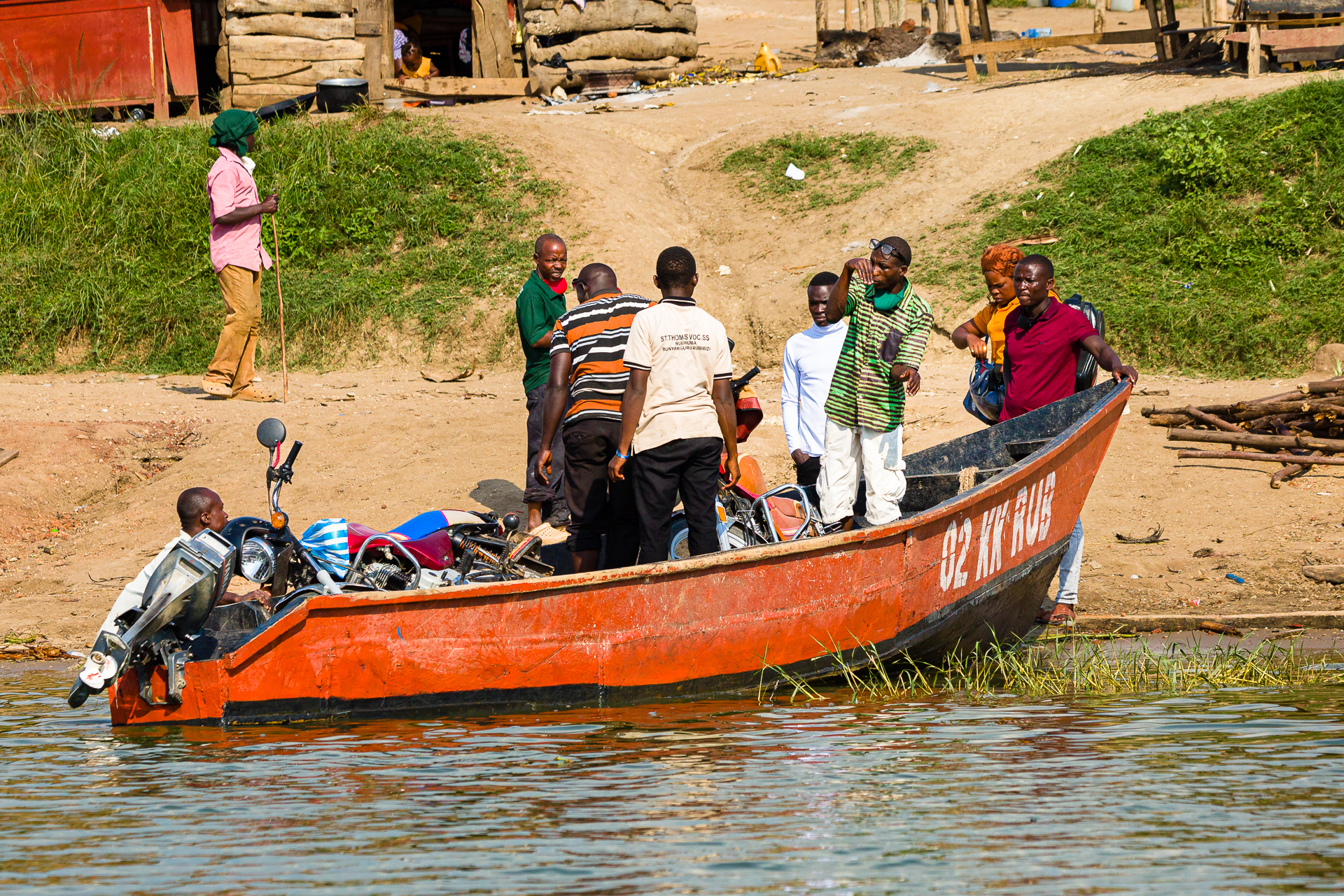
Even a Boda Bode can be transported on those little boats
The drive from Kasenyi Safari Camp to Ishasha Jungle Lodge is approximately 50 kilometers and takes approximately 2-3 hours, depending on the road conditions and the route taken. For Innocent this it is about 10 hours. The route usually involves driving through the park on a dirt road, which can be bumpy and dusty at times. Along the way, we spot buffalos, antelopes, and some baboons
The drive passes through the Ishasha sector of the park, which is known for its tree-climbing lions. The road soon crosses the Ishasha River, a seasonal waterway that can be dry or flooded depending on the time of year and we see hippos and a variety of bird species around the river banks.
We are warmly welcomed in Ishasha. One of the hotel staff offers us to go on a walking safari with him. He had seen a blue Turaco nearby in the morning. We follow him after we have brought our suitcases to our hut, as we still have some time until lunch, it is fun to roam through the forest with the nice employee and look for the blue Turaco. Unfortunately, the bird sits quite high in the tree. As soon as we get closer, it disappears again. But we still see a colubus monkey before we go back to the main house.
In the afternoon we go in search of the tree climbing he drive from Kasenyi Safari Camp to Ishasha Jungle Lodge in Queen Elizabeth National Park is approximately 50 kilometers and takes approximately 2-3 hours, depending on the road conditions and the route taken. Unfortunately, we are not lucky at least as far as the lions are concerned. Nevertheless, we see many other animals. We also see the blue Turaco in the end when we return to our accommodation. Cool.
Innocent promised us another surprise for the evening. We have no idea what’s coming. After dinner we order a beer and sit down a bit in the outdoor area. Suddenly, a horde of children storm the square accompanied by a few adults. And what happens then still gives me goosebumps.
Suddenly it is dead silent. Then a bush drum sounds and the children begin to sing and dance. The sound is indescribable and echoes again in the jungle.
The children are from the local school. Her musical revolves around the illegal hunting of gorillas and other wildlife. It shows that although poachers can solve one or the other money problem in the short term, it is better to rely sustainably on the protection and preservation of animals. Because this attracts tourists and leads to regular income. The project is supported by the school and, of course, cannot do without additional donations.
Of course, we support the project and are happy that the children sing and dance for over an hour. There are really a few talents there. In the meantime, the service ladies of the lodge and also the cook and the kitchen helpers as well as the other employees have joined. Now everyone is dancing. The jungle is shaking.
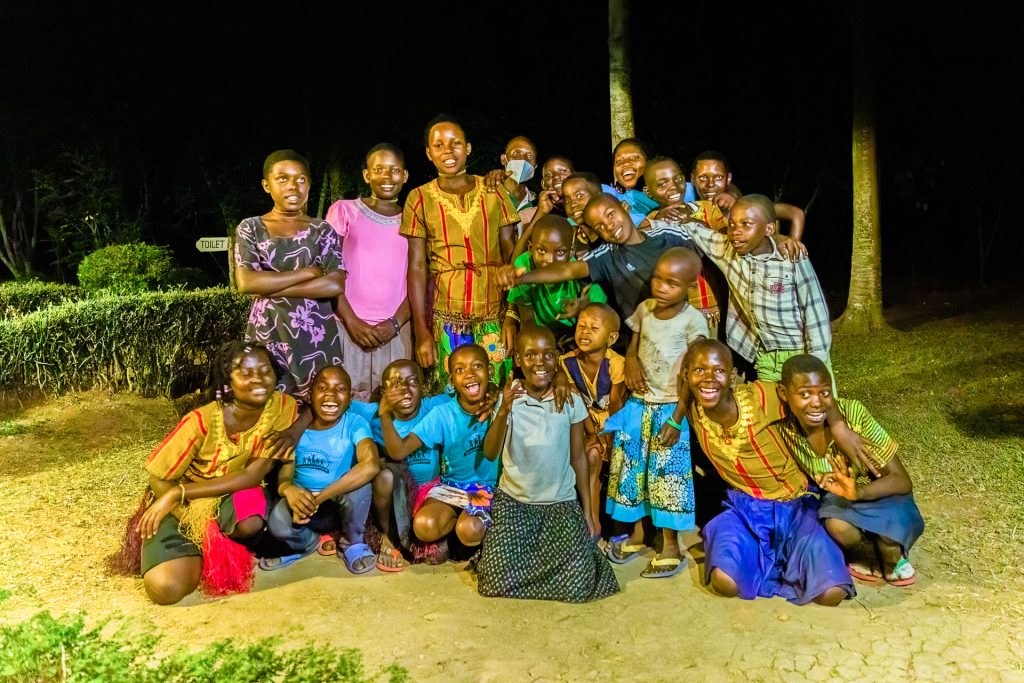
Kids from the school project against poaching
A great evening that I will never forget. Tomorrow we will try our luck again with the lions before we continue to Bwindi.
Portfolio
Uganda
"Africa has her mysteries, and even a wise man cannot understand them. But a wise man respects them" — Miriam Makeba
Birds Uganda
“Some birds are not meant to be caged, that's all. Their feathers are too bright, their songs too sweet and wild. So you let them go, or when you open the cage to feed them they somehow fly out past you. And the part of you that knows it was wrong to imprison them in the first place rejoices, but still, the place where you live is that much more drab and empty for their departure.” ― Stephen King, Rita Hayworth and Shawshank Redemption
Wildlife Uganda
“The more you learn about the dignity of the gorilla, the more you want to avoid people.” - Diane Fossey



